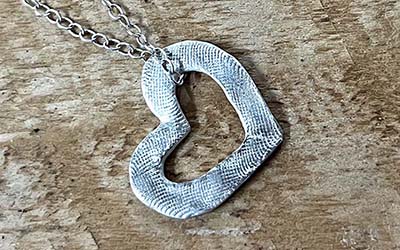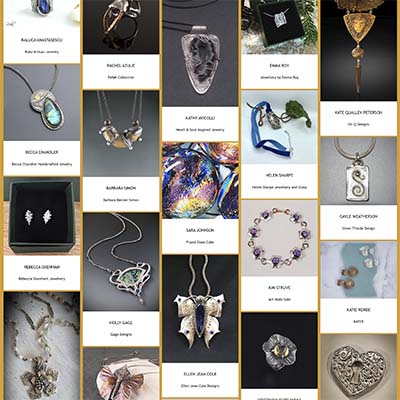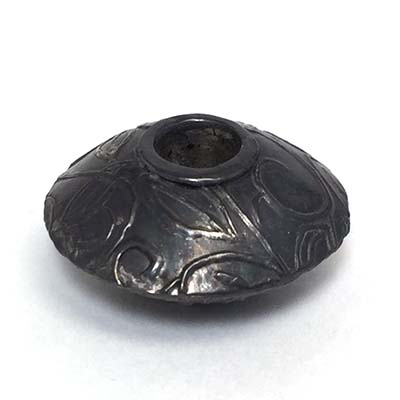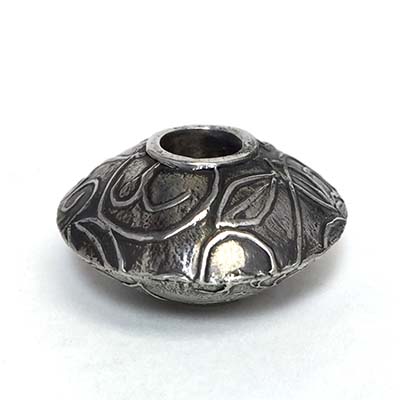About Patina
Some of the earliest known examples of colored metal objects are about 5000 years old. Early Roman writers noted the difference between naturally aged metals, and those that were chemically altered, and the Japanese have a long history of experimenting with complicated patina methods to achieve very specific colors on copper alloys. Modern makers will find numerous ways to enhance the color of metal depending on the type of metal used and the look you are hoping to achieve.
This article will describe a few ways to patina metal which work well with metal clay.
Clean It Up
Patinas on metal clay appear more vivid on a highly burnished surface. Instead of sinking into the porous body of the sintered metal clay, burnishing enables the color to stay on the surface.
The best way to produce beautiful results is to clean and degrease the metal before applying any kind of treatment. A simple soap and water scrub will remove body oils or residues from the polishing process that may remain on the metal.
Stay Safe
Some of the processes described below can irritate skin or erode cloth. Wear safety goggles, gloves, and an apron whenever working with chemicals and be sure to work in a well-ventilated room or outside.
Patina
Moisture and naturally occurring chemicals in the air or on our bodies accelerate the process of tarnishing, creating colored patinas like the blue-green Verdigris of copper and bronze or the black surface of aged sterling silver. The problem is that this way of coloring metal takes a lot of time! Over the centuries many recipes have been created to patina both ferrous and nonferrous metals, using heat and chemicals to help speed the process.
Two of the most popular chemicals used for antiquing or creating colorful patinas on metals are dilute solutions of hydrochloric acid and Liver of Sulfur (LOS).
Hydrochloric Acid
Hydrochloric acid is sold under the trade names Gosiba, Blackening Agent, Black Max, Jax, and others. They can all be used to add a rich, black, antiqued look to both fine and sterling silver. Applied with a steel brush they will also darken gold. Hydrochloric acid should be applied to room temperature metal right out of the bottle. It creates a deep black patina immediately, and can either be brushed onto the metal, or decanted into a larger, all plastic container for dipping (it will corrode metal parts).
Neutralize the acid remaining on the metal by dipping it in a warm water and baking soda bath.
How -To: Heat water in a bowl and add baking soda until it no longer dissolves. Drop in the patinated work and let sit for a minute or two. Remove and rinse in clear water. Once the neutralizing process is finished, any remaining baking soda liquid can be poured down the drain.
Caution and common-sense safety measures should always be taken when working with this product, but the solution sold for jewelry making is relatively safe to work with. While it is not commercial strength, it is an acid and will sting if you have a cut on your hands. Using a brush may be a safer method than dipping your work.
Black Max, top unpolished, bottom polished. Photos: Lora Hart
Video: Black Max patina applied with a water pen
Julia Rai, Sunstone Necklace, photo: Paul Mounsey
Liver of Sulfur
Liver of sulfur (LOS) is a salt, not an acid and will not need to be neutralized after use. LOS can be used on silver, copper and bronze, and creates a range of colors from a subtle golden tone to bronze, purple, pink, blue and through to a grey-ish brown black. Adding ammonia, salt, and even coffee will help brighter colors develop more reliably. Liver of sulfur comes in a variety of forms: gel, liquid, or solid chunks. The liquid and chunks are more sensitive to air and moisture and can quickly lose potency, but the gel is more stable over time.
How-To: fill a bowl with hot, but not boiling water and add small amounts of LOS until the water is a lemony yellow. Dip the work in the warm solution, then into a bowl of cold water, alternating between them until the metal is the color you like. Immediately plunge into ice water to stop the color change.
Video: Using Liver of Sulfur
Green Patinas
Copper, bronze, and brass naturally form a vibrant green patina called Verdigris. You can replicate this look on jewelry or sculpture using vinegar and salt and then fuming with ammonia or use a commercial preparation like Tiranti Cupra, or Jax Green Patina. Please search the internet for more complete instructions if you want to try these methods.
How-To: to fume pieces, find a container – glass or plastic – with a tight lid. Put your pieces in the bottom and sprinkle with vinegar and then salt. Put a small open container of household ammonia into the container and put the lid on. This also works inside a Ziploc bag. Leave it to develop for several days. When you remove the lid, stand well back as the vapors from the ammonia in the enclosed space are very potent and will irritate eyes, nasal passages etc. Wear goggles too. The metal may have developed a crusty surface so rinse well under running water to reveal the patina. It can be sealed using Renaissance Wax (see below).
Statue of Liberty, photo: Daryan Shamkhali
Julia Rai, photo: Paul Mounsey
Heat Patina
Copper, bronze, and steel respond beautifully to the heat of the torch when creating patina. From yellows and pinks to dark reds and oranges, ‘painting’ the metal with a flame can produce a range of vibrant color and patterns. Accentuate the orang-y brown tones by applying a very thin layer of peanut oil before using the torch.
Sealing Patina
Surface treatments like patina will erode as jewelry is worn and skin or fabric burnish the metal. Patinas on rings and the backs of pendants will wear away more quickly than that on earrings. Patina in low depressions will last longer than on those on higher surfaces.
Colorful patinas are a result of how light strikes the surface of an object. When a sealant of any kind is applied over patinated metal, it will change the way light reflects, and not only will the vibrant blue, purple, and pink colors change, but the metal will look a little duller. Sealing black and golden-bronze patinas is a little easier, but they will still look a little different.
There are a few commercial sealants that artists have used, but even a sealant will erode when it is burnished by the body or fabric. All in all, it may be better to learn to love the way the metal looks as it ages, instead of trying to capture a chemical rainbow.















